Bulletin – December 2017 Payments Recent Developments in the ATM Industry
- Download 1.28MB
Abstract
The ATM industry in Australia is undergoing a number of changes. Use of ATMs has been declining as people use cash less often for their transactions, though the number of ATMs remains at a high level. The total amount spent on ATM fees has fallen, and is likely to decline further as a result of recent decisions by a number of banks to remove their ATM direct charges. This article discusses the implications of these changes for the competitive landscape and the future size and structure of the industry.
Introduction
In 2009, a set of reforms was introduced to the ATM industry, with support from the Reserve Bank, aimed at strengthening competition and efficiency in the ATM market. In part, the reforms focused on making it easier for new entrants to directly participate in the ATM system by clarifying their right to connect to the system and removing the potential for discriminatory pricing. It also introduced greater competition and transparency in ATM fees by removing the highly inflexible and opaque system of interchange fees and instead allowing ATM owners to set their own fees (‘direct charges’) to compete directly with one another for transactions. The reforms have had a number of effects, including encouraging the entry of new ATM deployers and increasing the number of ATMs, including in locations where they would not previously have been commercially viable.[1]
Since the reforms were introduced, the Bank has periodically undertaken surveys on the ATM industry to better understand trends in the market structure, ATM usage and direct charging. The Bank recently completed its fourth survey of ATM participants, which asked for information as at June 2017 (or the year to June 2017 for transactions).[2] The survey, which provides disaggregated data by ATM deployer, is reasonably comprehensive, covering over 95 per cent of all ATMs.
Drawing on the results of this survey and other data sources, this article discusses recent changes in the size and structure of the ATM industry, ATM use and fee arrangements. It finds that ATM use has continued to decline in recent years but that the number of ATMs remains close to its peak level. The total amount spent on ATM direct charges has fallen, mostly reflecting a reduced number of ATM withdrawals, and is likely to decline further given the recent decisions by a number of banks to scrap their ATM direct charges. The article discusses some of the possible implications of this change in fee arrangements and declining ATM use for the industry, including how it might affect the competitive landscape, as well as future consolidation and fleet rationalisation initiatives.
Trends in the Number and Use of ATMs
Data on the total number of ATMs in Australia are compiled and published by Australian Payments Network (AusPayNet). These data show that the number of ATMs has increased by about 25 per cent since the 2009 reforms were introduced, though there has been little net increase over the past two years (Graph 1). As at September 2017, there were 32,275 ATMs, only slightly below the peak of nearly 32,900 in December 2016. This represents over 1,300 ATMs per million inhabitants, which is relatively high by international standards (Graph 2).
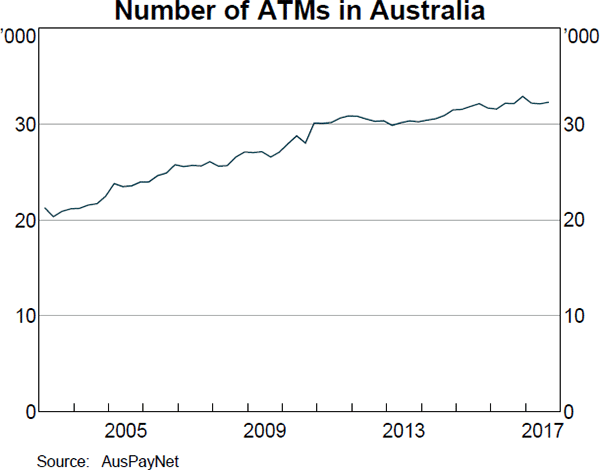
The share of the national ATM fleet owned by independent deployers has been rising over the past decade and this trend continued in the past few years according to the Bank's latest survey. Independent deployers operate standalone ATM networks that are not affiliated with any financial institution and which are often focused on convenience locations like petrol stations and licensed venues. They rely on the revenue generated by charging fees on all transactions, irrespective of the cardholder's financial institution, to support their networks.[3] By contrast, financial institutions primarily provide ATMs as a free service to their own cardholders, and have typically only charged ATM fees to cardholders of other financial institutions.
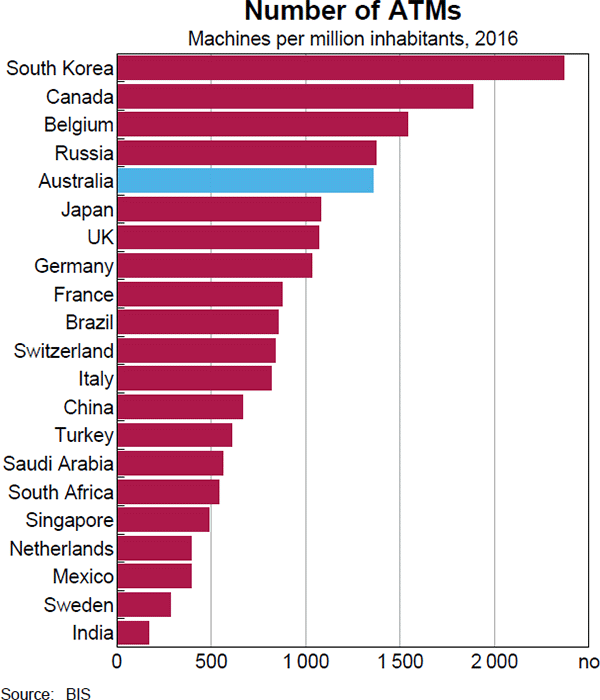
As at June 2017, 57 per cent of ATMs in Australia were independently owned, up from 55 per cent in mid 2015 and 49 per cent in 2010. The remaining 43 per cent were owned by financial institutions. The increase in the independent deployers' share reflects strong growth in their ATMs, while the number of bank-owned ATMs has declined over the past few years.
There has been significant consolidation in the independent deployer market over recent years. Cardtronics, an independent deployer, had the largest fleet in Australia in June at nearly 10,500 ATMs, which is around one-third of all ATMs (Table 1). Cardtronics is part of a US-based group that is also the largest deployer of ATMs globally. It entered the Australian market around the start of 2017 when it acquired DC Payments, which was the largest domestic independent deployer at the time. DC Payments had itself acquired a number of smaller independent networks over earlier years, including First Data's Cashcard ATM business in late 2016. Other large independent deployers, such as Banktech and Next Payments, have also expanded their ATM fleets since 2015, partly through acquisitions.
| July 2015 | June 2017 | |
|---|---|---|
| Cardtronics (acquired DC Payments in 2017) | 7,251 | 10,428(b) |
| Commonwealth Bank & Bankwest | 3,806 | 3,733 |
| Westpac Group (incl. St. George) | 3,055 | 2,933 |
| Banktech | 1,857 | 2,415 |
| ANZ | 2,606 | 2,337 |
| Next Payments | 1,080 | 2,300 |
| NAB(c) | 1,374 | 1,386 |
| Cuscal(c) | 1,130 | 1,111 |
| First Data | 4,691 | –(b) |
| Bendigo Bank | 868 | 756 |
| Bank of Queensland(c) | 591 | 619 |
| Suncorp(c) | 681 | 522 |
| Stargroup | 40 | 509(d) |
| Other independent deployers | 2,700 | 2,700 |
| Other financial institutions | 350 | 500 |
|
(a) A small number of ATMs that carry financial institutions' branding
but are owned and operated by an independent deployer are recorded in
data for independent deployers; other similar arrangements may be recorded
under financial institutions. This also applies to all other tables in
this article. Source: RBA |
||
Despite the increase in the share of independently owned ATMs, most Australian cardholders have had access to large networks of fee-free ATMs provided by their financial institutions. As at June 2017, three of the four major banks each had fleets of at least several thousand ATMs; NAB had the smallest fleet among the majors, but it is also part of the rediATM network, which means its customers had access to about 3,000 ATMs in that network on a fee-free basis (Table 1).[4] As discussed further below, a number of the banks, including all the majors, have recently removed the ATM withdrawal fees they used to charge non-customers. This means Australian cardholders can now generally access cash free of charge at around 11,000 financial institution ATMs across the country, which is a significant increase in access to fee-free ATM services.
While the number of ATMs in Australia remains close to all-time highs, the use of ATMs has been falling for a number of years. Data on ATM transactions are collected separately as part of the Bank's monthly Retail Payments Statistics collection. These data show that the number and value of ATM cash withdrawals have been declining since 2008, with the decline having accelerated over the past few years (Graph 3). Since 2013, the number of ATM withdrawals has fallen by an average of 5 per cent each year and is now about 25 per cent below its 2008 peak. Factoring in the rise in the number of ATMs over this period, the average number of withdrawals per ATM has nearly halved, from about 90 per day in 2007/08 to a little over 50 per day in 2016/17 (Graph 4).
The decline in ATM withdrawals primarily reflects a fall in the use of cash for transactions, with consumers increasingly opting to use electronic payment methods, particularly payment cards. The Bank's latest Consumer Payments Survey (CPS) indicated that cash payments fell from about 70 per cent of the number of consumer payments in 2007 to 37 per cent in 2016.[5] The widespread adoption of contactless card payments and the increasing use of cards for lower-value transactions have contributed to this trend. The reduced use of cash for transactions has meant that consumers are using ATMs less frequently to replenish their cash supplies. Consumers made an average of 0.4 cash top-ups per week at ATMs according to the 2016 CPS, compared with almost 1 in the 2010 survey. The number of eftpos cash-outs at supermarkets and other shops has also been declining since 2013 and is now about 25 per cent below its 2013 peak.
Because a large proportion of transactions at financial institution ATMs are fee-free, those ATMs tend to generate much higher transaction volumes than independently owned ATMs. Even though financial institutions made up less than half the national fleet, around 75 per cent of all ATM withdrawals and over 90 per cent of balance enquiries in the year to June 2017 took place at financial institution ATMs (Table 2). This equates to an average of 113 transactions (including balance enquiries) per machine per day at financial institution ATMs, compared with 24 per day at independently owned machines.
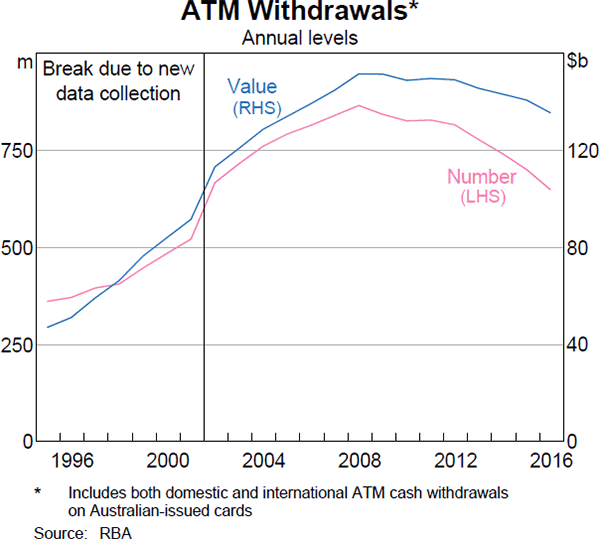
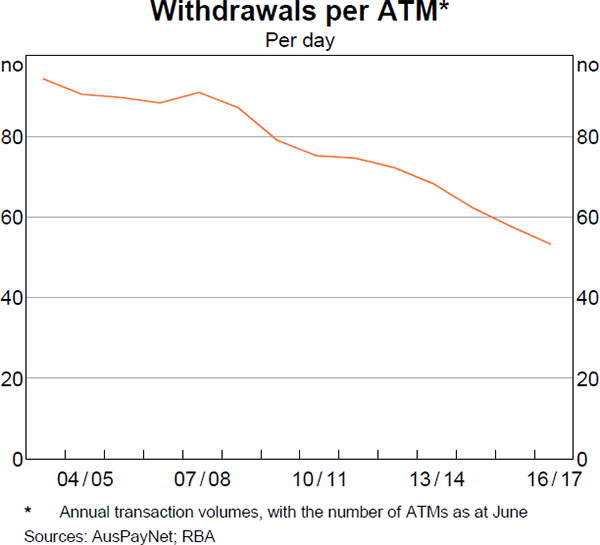
| Number of ATMs | Number of withdrawals | Number of balance enquiries | Transactions per machine per day | |
|---|---|---|---|---|
| June 2017 |
2016/17 (millions) |
2016/17 (millions) |
||
| Financial institutions | 13,467 | 435.3 | 120.4 | 113 |
| Per cent of total | 43 | 74 | 93 | |
| Independent deployers | 17,891 | 150.6 | 8.6 | 24 |
| Per cent of total | 57 | 26 | 7 | |
| Total(a) | 31,358 | 585.8 | 129.0 | 62 |
|
(a) This excludes a small number of ATMs not covered by the Bank's survey. Source: RBA |
||||
ATM Direct Charges
As noted earlier, as part of the 2009 reforms ATM owners were given the freedom to charge cardholders directly for ATM transactions, provided that the direct charge was disclosed clearly to the cardholder and the cardholder was given an opportunity to cancel the transaction without paying the fee, if they wished.[6] This was an improvement over the previous arrangement where fees for using a foreign ATM were charged to the cardholder's account, usually appearing on their statement well after the transaction had occurred. The direct charging model provides deployers with greater flexibility to determine their own pricing, which has made it possible to deploy ATMs in locations where it might not otherwise have been economic to do so.
The Bank's periodic ATM surveys have collected information on direct charges that ATM owners impose on withdrawals and balance enquiries. As at June 2017, the average direct charge for a foreign withdrawal (that is, from an ATM not owned by the cardholder's financial institution) was $2.37 (Table 3). This is only slightly higher than the previous survey in mid 2015, but about 20 per cent higher than the typical $2.00 ‘foreign fee’ that was charged before the 2009 ATM reforms.[7] This increase in the average fee for a withdrawal is broadly in line with CPI inflation over this period and has occurred in an environment where there has been a shift away from the use of cash and a decline in ATM withdrawals, which has increased unit costs.
The increase in the average direct charge for withdrawals has primarily been driven by higher fees at independent deployer ATMs. Direct charges on these ATMs averaged $2.63 in June, around 6¢ higher than in 2015, and up from $2.15 in 2010, an increase of 20 per cent. Among financial institution ATMs, the average direct charge was $2.04 in June, only about 5 per cent higher than in 2010.
While there has been a modest rise in the average direct charge for foreign ATM transactions since 2010, the number of transactions on which a fee is charged has been declining as more people seek out fee-free options. Estimates from the latest survey indicate that a direct charge was paid on around 29 per cent of all withdrawals in 2016/17, similar to that from the previous survey, but down from 33 per cent in the 2010 survey. It is estimated that cardholders paid around $420 million in ATM withdrawal fees in 2016/17. More than three-quarters of these fees were paid at independent deployer ATMs reflecting that those machines typically charge for all transactions and have higher average withdrawal fees than financial institution ATMs. Factoring in the decline in ATM use, the number of charged ATM withdrawals declined by around 30 per cent between 2010 and 2016/17, suggesting that cardholders paid around $110 million less for withdrawals in 2016/17 than in 2010. Combining ATM withdrawals and eftpos cash-outs, around 80 per cent of all cash withdrawals in 2016/17 did not attract a fee.
| Withdrawals | Balance Enquiries | |||||
|---|---|---|---|---|---|---|
| December 2010 | July 2015 | June 2017 | December 2010 | July 2015 | June 2017 | |
| Financial institutions | 1.94 | 2.02 | 2.04 | 1.68 | 2.01 | 1.27 |
| Independent deployers | 2.15 | 2.57 | 2.63 | 1.96 | 2.26 | 2.25 |
| Total | 2.04 | 2.33 | 2.37 | 1.82 | 2.15 | 1.82 |
|
Source: RBA |
||||||
Since the Bank's survey was conducted, a number of banks have removed the fees they charge for ATM debit card withdrawals and balance enquiries. Commonwealth Bank of Australia (CBA) made the announcement on 24 September that it was removing its $2.00 ATM withdrawal fee charged to non-CBA customers, effective immediately. The other major banks followed suit on the same day by announcing that they would also remove their ATM withdrawal fees by early October; Bankwest and Suncorp have also subsequently removed their withdrawal fees.[8] Fees charged for balance enquiries were also abolished, with at least two of the major banks having already dropped this fee during the past year.
These recent pricing changes mean that close to 11,000 ATMs (about 80 per cent of all financial institution ATMs and around one-third of all ATMs) are now fee-free for Australian cardholders. This is a significant increase in access to fee-free ATM services given that previously the largest fee-free ATM network, that belonging to CBA, provided fee-free access to about 4,300 ATMs for CBA and Bankwest customers (including some ATMs outsourced to an independent deployer).
Assuming other deployers have kept their fees at the same level as when the Bank's survey was conducted, the average direct charge for a withdrawal, where it applies, is now estimated to be a little under $2.60. Among the 20 per cent of financial institution ATMs that still have direct charges, the average withdrawal fee is about $2.20.
The various ATM fee changes are reflected in the shifting distribution of ATM fees. In 2010, three-quarters of ATMs charged $2.00 for a withdrawal, with only 17 per cent charging more (Graph 5). While $2.00 was still the most common withdrawal fee in June this year, close to one-third of ATMs charged $2.50 at that time, and around one-quarter charged from $2.75 to $3.00. However, following the removal of withdrawal fees by various banks, the distribution has changed significantly: there is now no charge for foreign withdrawals at around one-third of ATMs, whereas most of these ATMs had previously charged $2.00.
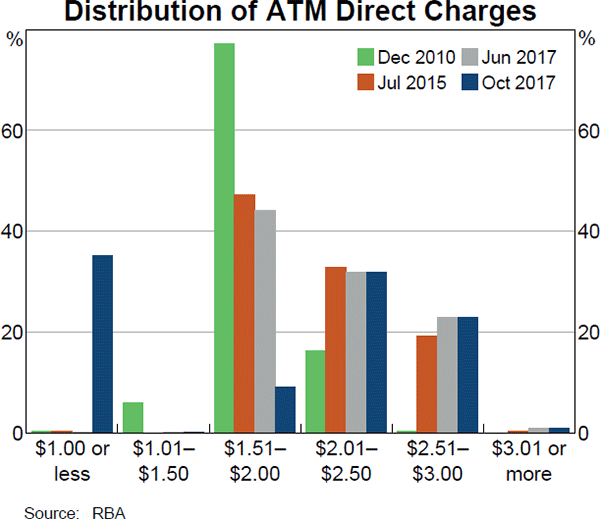
Independent deployer ATMs have the greatest variation in ATM fees; as at June this year, their withdrawal fees ranged from zero to $8.00, though most were around $2.50 to $3.00. About 300 ATMs (less than one per cent of all ATMs) charged more than $3.00; many of these ATMs are located in pubs/clubs and other adult entertainment venues. Interestingly, there are a small number of independently owned ATMs that operate a variable pricing model, levying a direct charge based on a percentage of the amount withdrawn.
The average direct charge on balance enquiries was lower than for withdrawals, at $1.82 in June, and had declined since 2015. This was largely due to two major banks removing their balance enquiry charges during the past year. Following the recent decisions by a number of other banks to scrap their ATM fees, the average balance enquiry fee (when charged) is now estimated to have risen to about $2.30, though only a small fraction of enquiries are now charged.
Implications of the Removal of Direct Charges
The decisions by a number of the banks to remove their ATM fees could have a number of implications for the ATM industry. With the removal of withdrawal fees providing a much larger network of fee-free ATMs, it will now be even easier for cardholders to avoid paying fees. As a result, those ATM deployers that continue to charge withdrawal fees – particularly independent deployers, who typically charge the highest average fees – may face additional competitive pressure, especially where they have ATMs in close proximity to fee-free bank ATMs. That said, many independently owned ATMs are in convenience locations not serviced by bank ATMs (such as pubs and clubs) and so they may be shielded somewhat from this competitive pressure.
For those banks that eliminated their withdrawal fees, the direct reduction in their revenue will be relatively small, especially given the decline in ATM use over recent years. In particular, based on the Bank's survey, it is estimated that withdrawal fees paid at ATMs owned by the major banks in 2016/17 totalled around $50 million. As noted earlier, the bulk of ATM fees has been paid at independent deployer ATMs rather than bank-owned ATMs.
Given that cardholders can now effectively use most bank ATMs on a fee-free basis, it is likely that having a large ATM fleet will be viewed as less of a source of competitive advantage to banks than it was in the past. With ATM use declining rapidly and the costs of ATM deployment continuing to rise, the removal of ATM fees may strengthen the case for deployers to reduce the size of their ATM fleets. Having multiple bank ATMs side-by-side or in close proximity (as can often be seen in shopping centres, for example) will make less economic sense now that all or most of those ATMs are fee-free.
Fleet rationalisation could occur in a number of ways. Some banks (and possibly independent deployers) might look to better optimise their own fleets by removing ATMs in low-density or low-use areas. Banks may look to pool part or all of their fleets with other banks under generically branded, shared service or ‘utility’ ATM models as a way to improve efficiency, while still maintaining adequate access for cardholders. A pooled network may enable the participants to remove ATMs that are co-located or in close proximity, which would reduce costs and help them sustain, and possibly grow, their joint network coverage. Indeed, before the recent announcements on direct charges, some banks had been in discussions about pooling their ATM fleets into a shared utility.
Facing similar downward trends in cash and ATM use, a number of other countries, particularly in northern Europe, have successfully implemented or are considering shared ATM models. For example, bank ATMs in Finland were outsourced to a single operator in the mid 1990s, while Sweden's five largest banks adopted a utility model earlier this decade. The large Dutch banks are currently looking to set up a joint ATM network to help ensure the continued wide availability of ATMs in the Netherlands even as cash use is decreasing.
While it is too early to assess the full impact of the recent announcements by the major banks, it is likely that they will focus attention on the growing disparity between the number of ATMs in Australia and the demand for ATM services. Some consolidation seems likely, and may even be desirable for the efficiency and sustainability of the ATM network, though it will be important that adequate access to ATM services is maintained, particularly for people in remote or regional locations, where access to alternative banking services is often limited.
Footnotes
The authors are from Payments Policy Department. [*]
For more information on the 2009 ATM reforms and their impact, see Flood and Mitchell (2016). [1]
Previous surveys were conducted in mid 2015 (Flood and Mitchell (2016)), late 2010 (Flood, Hancock and Smith (2011)), and early 2010 (Filipovski and Flood (2010)). [2]
Some independent deployers also own and operate some ATMs under outsourcing arrangements with financial institutions, which are usually fee-free for the financial institutions' cardholders. [3]
rediATM is an ATM network operated by Cuscal on behalf of over 90 partner financial institutions. The partners' cardholders can use any of the rediATMs across Australia without paying a direct charge fee. Suncorp recently joined the rediATM network, which will increase the number of ATMs in the network from about 3,000 to 3,300. [4]
Refer to Doyle et al (2017). [5]
With the encouragement of the Bank, the industry has also recently introduced new requirements that any ATM fees be clearly disclosed on the screen of the ATM before the cardholder begins a transaction, making it easier for the cardholder to leave and go to a machine with cheaper fees, if they wish. [6]
A foreign fee is a fee charged by a cardholder's own financial institution for a transaction on an ATM not owned by that institution. Financial institutions stopped charging these fees after the 2009 reforms when bilateral interchange fees were removed. [7]
Across all of these banks, the fee changes apply only to withdrawals made using Australian-issued debit cards, with customers using overseas-issued cards continuing to pay withdrawal fees. Direct charges for credit card cash advances also continue to apply. [8]
References
Doyle M, C Fisher, E Tellez and A Yadav (2017), ‘How Australians Pay: Evidence from the 2016 Consumer Payments Survey’, RBA Research Discussion Paper No 2017-04.
Filipovski B and D Flood (2010), ‘Reform of the ATM System – One Year On’, RBA Bulletin, June, pp 37–45.
Flood D, J Hancock and K Smith (2011), ‘The ATM Reforms – New Evidence from Survey and Market Data’, RBA Bulletin, March, pp 43–49.
Flood D and S Mitchell (2016), ‘The ATM System since the 2009 Reforms’, RBA Bulletin, March, pp 31–38.